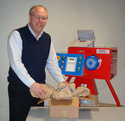Dispelling the ‘myths’ of plastics packaging
23 June 2010It makes business sense to reduce packaging wherever possible: saving costs and resources is a key driver, but as technology and design techniques have advanced, packaging techniques have too. With this in mind, Stuart Roberts, European Director of Marketing at leading global packaging company Sealed Air, addresses the top five most common ‘plastics packaging misconceptions’ to help dispel the ‘myths’ and aid a greener and more cost effective future.
Myth: Plastics packaging is the biggest single cause of unrecoverable waste in the European Union.
Truth: This is a common misconception - unrecovered packaging currently accounts for no more than 3% of all the waste that goes into final disposal*. In addition, because of its low weight and relative strength, plastics is one of the most energy efficient, robust and economic delivery methods available. Plastics has a high calorific content, which allows energy recovery methods to be utilised efficiently if recycling is not possible.
Myth: The only use of plastics packaging is to promote and help to sell the product it contains.
Truth: No. The primary use of plastics packaging is to protect products and deliver all types of goods intact. As for secondary and tertiary packaging, such as plastics shrink wrap, pallets and crates, this serves an essential purpose in facilitating the transport of greater quantities of products at once, which makes the transportation process more economical, saving energy and keeping costs down for the consumer. The right choice of plastics packaging solution can allow companies to meet deadlines and maintain their reputation with customers by reducing the number of damages incurred during transit.
Myth: Plastics packaging has a negative impact on the environment.
Truth: Plastics packaging has a number of hidden benefits that offer huge advantages to the environment and to consumers. Following use, the energy component of plastics packaging can be recovered through incineration, placed in landfill, or recycled into granules that can be used to make other plastics packaging. Increasingly, new techniques are being used to recover plastics from the waste stream for use as feedstock for other products. In addition, it is lightweight, extends shelf life, ensures fresh delivery of goods and reduces the amount of overall waste arising from packaging. In comparison, it has been suggested that producing recycled paper uses more energy compared to virgin paper production, is more polluting and may make a greater contribution to climate change.
Myth: Commercial organisations don’t consider the environmental impact of their plastics packaging waste.
Truth: Increasingly, organisations are looking for ways to reduce the impact of their operations on the environment. More and more plastics products are being manufactured using ‘pre-consumer’ recycled content. Although landfill wastage is inevitable, many companies are working to minimise the number of discards from the point of sale through to the creation of ‘closed loop schemes’ that recover plastics packaging from use and encourage the expansion of energy facilities to recover natural energy from products when recycling is not an option.
Myth: Landfill is the worst way to dispose of plastics packaging.
Truth: It is a commonly held belief that landfill is the worst way of disposing of plastics waste. Incineration is the least favorable option in terms of the impact on global warming, as more carbon dioxide is emitted by burning plastics than by burning gas or coal. In some cases, landfill can be a useful option: it can be used to fill up holes in the ground, such as those caused by quarrying or disused mines; or it can also be used for reclaiming land. Often it is a question of what the land is filled with and how it is then managed. On balance, the best environmental option is to invest in technology to produce high quality recycled plastics.
*The European Organisation for Packaging and the Environment
Views expressed on this page are those of the author and may not be shared by thispublication. If you wish to comment on this article, please write to the Editor: maureenbyrne@globaltrademedia.com
Stuart Roberts, European Director of Marketing, Sealed Air. Stuart Roberts


